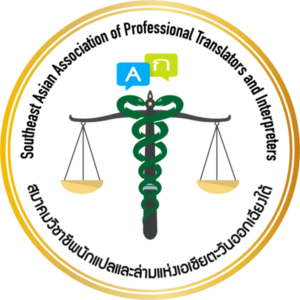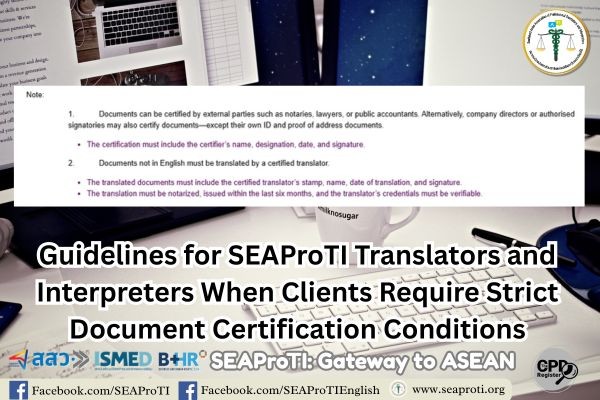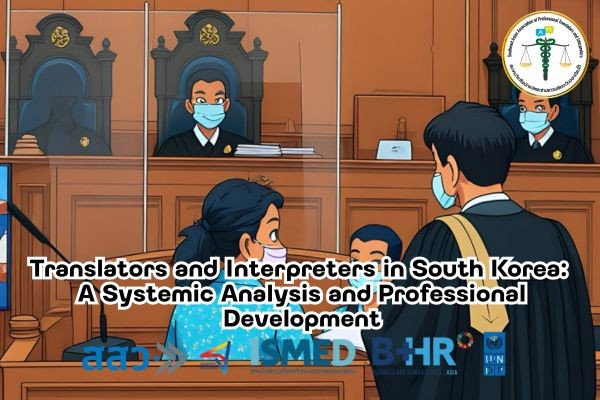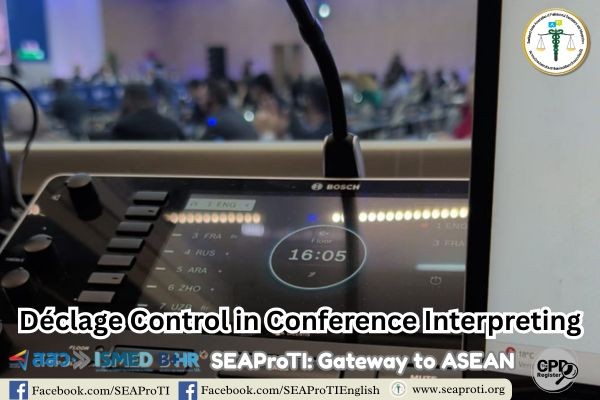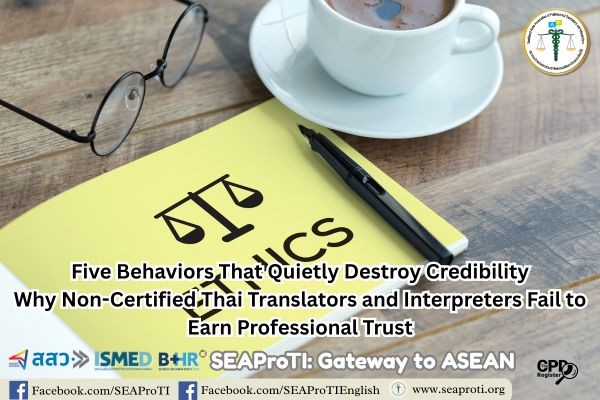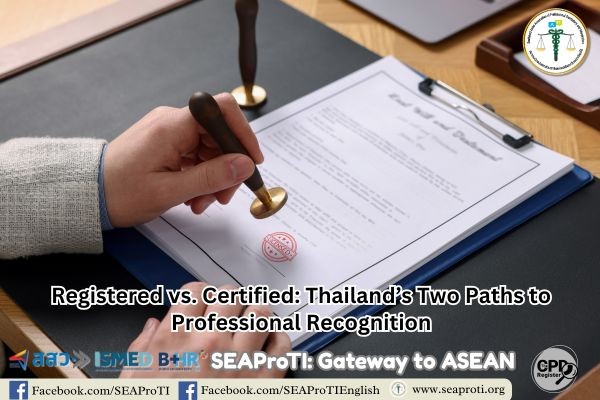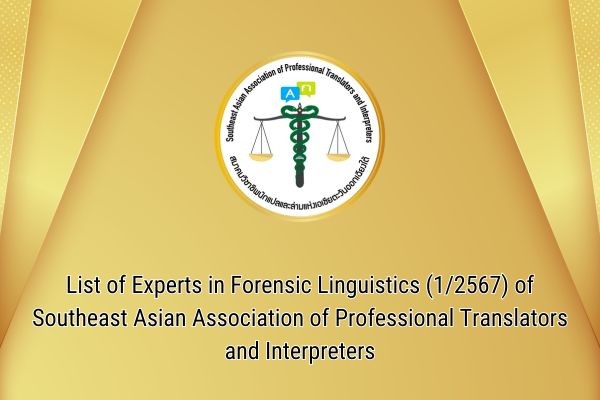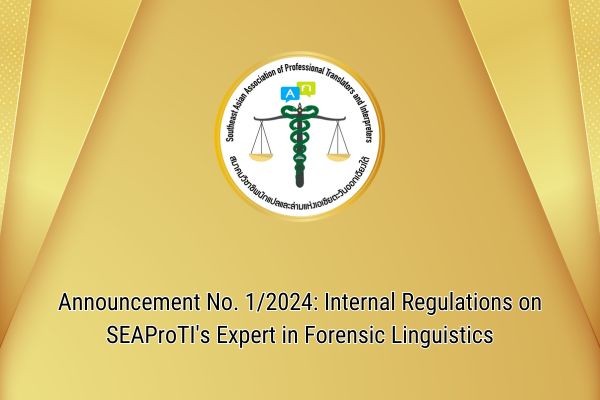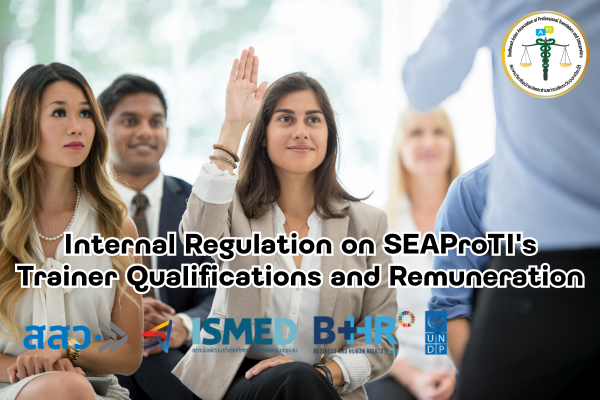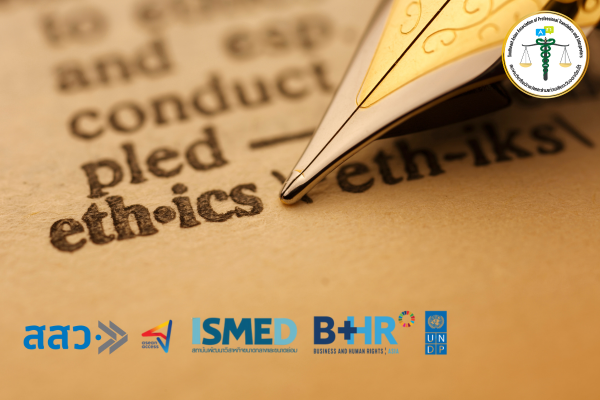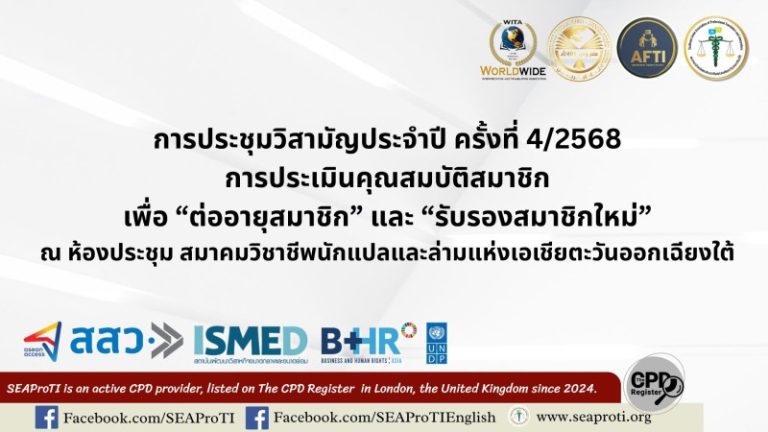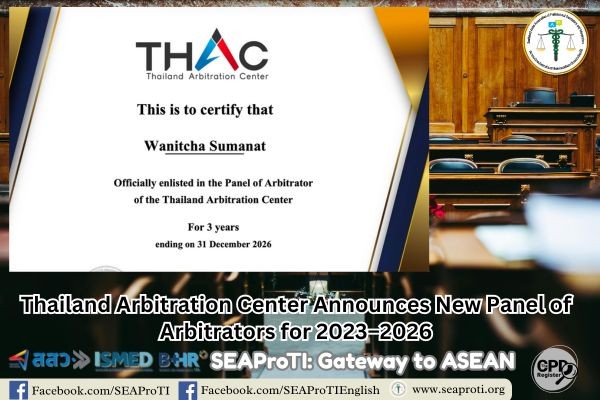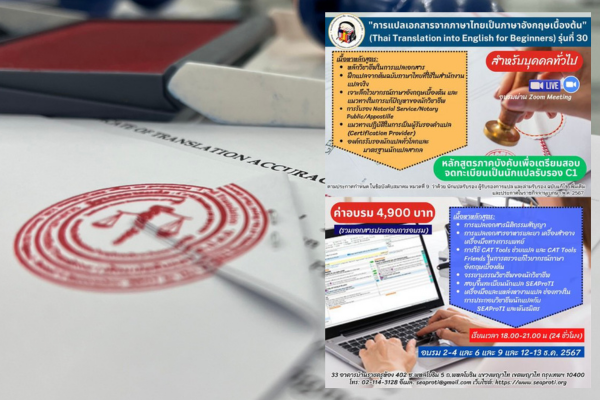Guidelines for SEAProTI Translators and Interpreters When Clients Require Strict Document Certification Conditions
9 November 2025, Bangkok — Translations prepared for business transactions, financial compliance, audits, immigration, or visa applications increasingly come with strict requirements regarding certification format, verifiability of translator credentials, validity period of translated documents, and notarization. These conditions reflect growing international expectations for trustworthiness, accuracy, and traceability in legal and legally binding translations. Such requirements align with global practices in high-stakes legal-effect translations.
SEAProTI translators and interpreters must therefore understand the correct procedures to maintain professional standards, mitigate legal risks, and ensure credibility for clients both domestically and internationally.
1. Verify that Your Qualifications Meet the Client’s Requirements
Before accepting any assignment, practitioners must confirm that they genuinely meet the stated criteria, such as:
- Being a Certified Translator/Interpreter under a recognized and valid standard
- Having a translator’s certification stamp
- Being able to provide full name, position, date, and signature as required
- Possessing verifiable credentials
SEAProTI practitioners may verify their own status, registration number, stamp number, full name, and qualifications from SEAProTI’s directory:
If the practitioner does not meet all requirements or does not appear in SEAProTI’s database, the assignment should be declined politely to avoid future disputes (Hale, 2022).
2. Clarify the Differences Between Certification, Notarization, and Legalization
Clients often misunderstand the distinctions and may assume that a translator’s certification is equivalent to a notarial act or a state-level endorsement. Practitioners should explain:
- Certification: A translator certifies that the translation is accurate and complete.
- Notarization: A notary/lawyer notarizes the translator’s signature, not the quality of the translation.
- Legalization: A government authority (e.g., Ministry of Foreign Affairs or embassies) certifies the document or signature for official use.
Clear explanation helps prevent common misunderstandings in international document processing (Kelly & Zetzsche, 2020).
3. Coordinate Properly With a Notary or Lawyer When Notarization Is Required
Translators must not sign as a “Notary Public” without legal qualification, as doing so violates Thai law.
If notarization is required:
- Coordinate with a legally licensed notary
- Disclose additional fees and processing time to the client
- Ensure signatures and document formats comply with notarial practice
4. Issue Updated Documents When the Client Requires Translations Dated Within Six Months
Many institutions—banks, insurance companies, embassies, audit bodies—require translated documents to be issued within the past six months. The practitioner must therefore:
- Reissue the translation
- Clearly indicate the translation date and certification date
- Confirm that the certification stamp used is the latest version
This aligns with international certification standards (ISO 17100:2015).
5. Maintain Complete Records for Professional Protection
Practitioners should retain:
- A copy of the certified translation
- Records of delivery and communication
- Names and positions of requesting parties
- All relevant instructions and clarifications
Such documentation is essential in case of disputes, including rejection by end-users (Gouadec, 2007).
6. Decline Assignments With Unreasonable or Non-compliant Requirements
Examples of requirements that practitioners should decline include:
- Requests to use a non-standard or nonexistent SEAProTI seal
- Requests equivalent to a “sworn translator” designation in jurisdictions where such status does not exist
- Requests to sign documents in a capacity the translator does not legally hold
- Requests for excessive personal data disclosure
Translators have the right to protect their professional boundaries and credibility (Pöchhacker, 2016).
Conclusion
Strict certification requirements in translation work are increasingly common as translated documents influence administrative approval, financial compliance, and international legal procedures. SEAProTI practitioners must therefore follow the correct protocols, understand the distinctions between certification, notarization, and legalization, and uphold international professional standards. Doing so ensures credibility, legal safety, and high levels of client confidence.
References
- Gouadec, D. (2007). Translation as a profession. John Benjamins.
- Hale, S. (2022). Community interpreting: International standards and expectations. Routledge.
- ISO 17100:2015. (2015). Translation services — Requirements for translation services. International Organization for Standardization.
- Kelly, N., & Zetzsche, J. (2020). Found in translation: How language shapes our lives and transforms the world. Penguin.
- Pöchhacker, F. (2016). Introducing interpreting studies (2nd ed.). Routledge.
About Certified Translators, Translation Certifiers, and Certified Interpreters of SEAProTI
The Southeast Asian Association of Professional Translators and Interpreters (SEAProTI) has formally announced the qualifications and requirements for registration of Certified Translators, Translation Certification Providers, and Certified Interpreters in Sections 9 and 10 of the Royal Gazette, published by the Secretariat of the Cabinet, Office of the Prime Minister of Thailand, on 25 July 2024 (Vol. 141, Part 66 Ng, p. 100). Certified Translators, Translation Certification Providers, and Certified Interpreters
The Council of State has proposed the enactment of a Royal Decree, granting registered translators and recognized translation certifiers from professional associations or accredited language institutions the authority to provide legally valid translation certification (Letter to SEAProTI dated April 28, 2025)
SEAProTI is the first professional association in Thailand and Southeast Asia to implement a comprehensive certification system for translators, certifiers, and interpreters.
Head Office: Baan Ratchakru Building, No. 33, Room 402, Soi Phahonyothin 5, Phahonyothin Road, Phaya Thai District, Bangkok 10400, Thailand
Email: hello@seaproti.com | Tel.: (+66) 2-114-3128 (Office hours: Mon–Fri, 09:00–17:00)
แนวทางปฏิบัติของนักแปลและล่าม SEAProTI เมื่อผู้ว่าจ้างกำหนดเงื่อนไขการรับรองเอกสารอย่างเข้มงวด
9 พฤสจิกายน 2568, กรุงเทพมหานคร – งานแปลเอกสารเพื่อใช้ในกระบวนการทางธุรกิจ การเงิน การตรวจสอบ หรือการยื่นขอวีซ่า มักมีเงื่อนไขเฉพาะที่เข้มงวดมากขึ้นเรื่อย ๆ ทั้งในด้านรูปแบบการรับรอง (certification) การตรวจสอบคุณวุฒิผู้แปล (verifiability) การกำหนดอายุเอกสาร (validity period) และการรับรองโดยโนตารี (notarization) เงื่อนไขเหล่านี้สะท้อนความต้องการด้านความน่าเชื่อถือ ความถูกต้อง และการตรวจสอบย้อนกลับ (traceability) ของเอกสารที่ใช้ในกระบวนการระหว่างประเทศ ซึ่งเป็นแนวโน้มสากลของงานแปลทางกฎหมายและงานแปลที่มีผลผูกพัน (legal-effect translations)
นักแปลและล่ามที่เป็นสมาชิก SEAProTI จึงต้องมีความรู้ ความเข้าใจ และแนวปฏิบัติที่ถูกต้อง เพื่อรักษามาตรฐานวิชาชีพ ป้องกันความเสี่ยงทางกฎหมาย และสร้างความเชื่อมั่นให้แก่ผู้ใช้บริการ ทั้งในประเทศและต่างประเทศ
1. ตรวจสอบคุณสมบัติว่าตรงตามเงื่อนไขผู้ว่าจ้างจริงหรือไม่
ก่อนรับงาน นักแปลต้องประเมินว่าตนเองมีคุณสมบัติครบถ้วนตามที่ผู้ว่าจ้างกำหนด เช่น
- เป็น Certified Translator/Interpreter ตามมาตรฐานที่ใช้ได้จริง
- มี ตราประทับรับรอง (translator’s certification stamp)
- สามารถลงชื่อ–นามสกุล–ตำแหน่ง–วันที่ตามข้อกำหนดของผู้ว่าจ้าง
- คุณวุฒิสามารถตรวจสอบได้ (verifiable credentials)
ตรวจสอบสถานะการขึ้นทะเบียน เลขตราประทับ ชื่อนามสกุล และคุณวุฒิของนักแปลและล่ามของ SEAProTI ได้ที่ ไดเร็คทอรี่ของสมาคม
หากคุณสมบัติไม่ครบถ้วน หรือไม่ปรากฎบทฐานข้อมูลของเรา ควรปฏิเสธงานโดยสุภาพเพื่อป้องกันข้อพิพาทในอนาคต (Hale, 2022)
2. อธิบายความหมายของ Certification, Notarization และ Legalization ให้ผู้ว่าจ้างเข้าใจ
ผู้ว่าจ้างบางรายเข้าใจผิดว่า “การรับรองจากนักแปล” เท่ากับ “โนตารี” หรือ “การรับรองจากรัฐ” ซึ่งไม่ถูกต้อง นักแปลควรอธิบายดังนี้:
- Certification = การแปลและรับรองว่าถูกต้องโดยนักแปลผู้มีคุณสมบัติตามข้อกำหนด
- Notarization = การรับรอง “ลายมือชื่อของนักแปล” โดยทนายความ/โนตารี ไม่ใช่การรับรองคุณภาพการแปลล
- Legalization = การให้รัฐ (เช่น กระทรวงการต่างประเทศ หรือสถานทูต) รับรองเอกสารอีกชั้นหนึ่ง
การอธิบายให้ชัดเจนช่วยลดความเข้าใจผิด ซึ่งเป็นปัญหาพบบ่อยในงานแปลระหว่างประเทศ (Kelly & Zetzsche, 2020)
3. ประสานงานโนตารีหรือทนายความอย่างถูกต้อง หากงานต้องการ Notarization
นักแปลต้องไม่ลงนามในฐานะ “Notary Public” หากไม่มีคุณสมบัติ เพราะเป็นการกระทำผิดกฎหมายตามพระราชบัญญัติทนายความ นักแปลควรประสานงานกับโนตารีที่ได้รับใบอนุญาตและแจ้งค่าใช้จ่ายเพิ่มเติมให้ผู้ว่าจ้างทราบก่อนเริ่มงาน
4. จัดทำเอกสารใหม่เมื่อผู้ว่าจ้างกำหนดอายุเอกสารภายใน 6 เดือน
ผู้ว่าจ้างหลายแห่ง เช่น ธนาคาร บริษัทประกัน สถานทูต และหน่วยงานตรวจสอบ มักกำหนดว่าเอกสารแปลต้องมีวันที่ไม่เกิน 6 เดือน นักแปลจึงต้องทำการ
- ออกเอกสารใหม่
- ระบุวันที่แปลและวันที่รับรองให้ชัดเจน
- ตรวจสอบว่าตราประทับยังเป็นเวอร์ชันล่าสุด
- แนวปฏิบัตินี้สอดคล้องกับมาตรฐานการรับรองเอกสารสากล (ISO 17100:2015)
5. เก็บหลักฐานการทำงานทุกรายการเพื่อความปลอดภัยทางวิชาชีพ
ควรเก็บ:
- สำเนางานแปลที่มีตราประทับ
- รายละเอียดการส่งมอบงาน
- รายการสื่อสารระหว่างผู้ว่าจ้าง
ชื่อ–ตำแหน่งของผู้ร้องขอ
เพื่อรองรับกรณีมีข้อพิพาท เช่น ผู้ว่าจ้างปฏิเสธผลงาน หรือหน่วยงานปลายทางปฏิเสธเอกสาร (Gouadec, 2007)
6. หากเงื่อนไขไม่สมเหตุสมผล นักแปลมีสิทธิที่จะปฏิเสธงาน
ตัวอย่างเงื่อนไขที่ควรปฏิเสธ เช่น
ต้องการให้ใช้ตราที่ไม่ใช่มาตรฐานของสมาคม
ต้องการใบรับรองเทียบเท่า sworn translator ในประเทศที่ไม่มีสถานะดังกล่าว
ต้องการให้ลงนามในสถานะที่นักแปลไม่มีสิทธิใช้
ต้องการเปิดเผยข้อมูลส่วนบุคคลเกินความจำเป็น
นักแปลมีสิทธิรักษาขอบเขตงานและปฏิเสธงานที่เสี่ยงต่อความน่าเชื่อถือของตนเอง (Pöchhacker, 2016)
ข้อสรุป
งานแปลที่มีเงื่อนไขเข้มงวดไม่ใช่เรื่องแปลกในยุคที่เอกสารมีผลต่อการอนุมัติทางธุรการ การเงิน และกฎหมายระดับสากล นักแปลและล่าม SEAProTI จึงต้องมีแนวทางปฏิบัติที่ถูกต้อง มีความรู้เรื่อง Certification–Notarization–Legalization อย่างรอบด้าน และรักษามาตรฐานวิชาชีพตามหลักสากล เพื่อความน่าเชื่อถือ ความปลอดภัยต่อวิชาชีพ และความพึงพอใจของผู้ใช้บริการ
เอกสารอ้างอิง (APA Style)
- Gouadec, D. (2007). Translation as a profession. John Benjamins.
- Hale, S. (2022). Community interpreting: International standards and expectations. Routledge.
- ISO 17100:2015. (2015). Translation services — Requirements for translation services. International Organization for Standardization.
- Kelly, N., & Zetzsche, J. (2020). Found in translation: How language shapes our lives and transforms the world. Penguin.
Pöchhacker, F. (2016). Introducing interpreting studies (2nd ed.). Routledge.
เกี่ยวกับนักแปลรับรอง ผู้รับรองการแปล และล่ามรับรองของสมาคมวิชาชีพนักแปลและล่ามแห่งเอเชียตะวันออกเฉียงใต้
สมาคมวิชาชีพนักแปลและล่ามแห่งเอเชียตะวันออกเฉียงใต้ (SEAProTI) ได้ประกาศหลักเกณฑ์และคุณสมบัติผู้ที่ขึ้นทะเบียนเป็น “นักแปลรับรอง (Certified Translators) และผู้รับรองการแปล (Translation Certification Providers) และล่ามรับรอง (Certified Interpreters)” ของสมาคม หมวดที่ 9 และหมวดที่ 10 ในราชกิจจานุเบกษา ของสำนักเลขาธิการคณะรัฐมนตรี ในสำนักนายกรัฐมนตรี แห่งราชอาณาจักรไทย ลงวันที่ 25 ก.ค. 2567 เล่มที่ 141 ตอนที่ 66 ง หน้า 100 อ่านฉบับเต็มได้ที่: นักแปลรับรอง ผู้รับรองการแปล และล่ามรับรอง
สำนักคณะกรรมการกฤษฎีกาเสนอให้ตราเป็นพระราชกฤษฎีกา โดยกำหนดให้นักแปลที่ขึ้นทะเบียน รวมถึงผู้รับรองการแปลจากสมาคมวิชาชีพหรือสถาบันสอนภาษาที่มีการอบรมและขึ้นทะเบียน สามารถรับรองคำแปหฟลได้ (จดหมายถึงสมาคม SEAProTI ลงวันที่ 28 เม.ย. 2568)
สมาคมวิชาชีพนักแปลและล่ามแห่งเอเชียตะวันออกเฉียงใต้ เป็นสมาคมวิชาชีพแห่งแรกในประเทศไทยและภูมิภาคเอเชียตะวันออกเฉียงใต้ที่มีระบบรับรองนักแปลรับรอง ผู้รับรองการแปล และล่ามรับรอง
สำนักงานใหญ่: อาคารบ้านราชครู เลขที่ 33 ห้อง 402 ซอยพหลโยธิน 5 ถนนพหลโยธิน แขวงพญาไท เขตพญาไท กรุงเทพมหานคร 10400 ประเทศไทย
อีเมล: hello@seaproti.com โทรศัพท์: (+66) 2-114-3128 (เวลาทำการ: วันจันทร์–วันศุกร์ เวลา 09.00–17.00 น.

